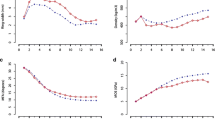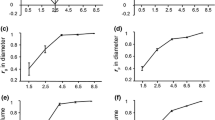Abstract
Context
Australian blackwood (Acacia melanoxylon), is a fast-growing, high-quality, appearance-grade timber species native to eastern Australia. Some of its key wood properties are percentage heartwood, heartwood colour, basic density, wood stiffness and green moisture content. Variation in these properties affects log value, processing and marketing.
Aims
This study aims to understand how genetics and environment affect these wood properties.
Methods
Stem cores were taken from 16 open-pollinated blackwood families from the island of Tasmania, Australia, which were planted across three 18-year-old progeny trials.
Results
Significant effects of genetics, environment and their interaction (GxE) were found for many of the wood properties examined. Both broad-scale and local environmental effects were apparent, with local effects associated with competition and/or allelopathy from a Eucalyptus globulus nurse crop present in one trial. No significant correlation of growth rate (i.e. stem diameter) with wood properties was detected at the family level apart from a positive relationship with heartwood width. At the phenotypic level, there were many significant correlations including growth rate with heartwood width, but not with basic density, or wood stiffness measured as standing tree time of flight. Faster growing trees had yellower heartwood while trees with higher basic and green densities tended to have darker, redder and less yellow heartwood.
Conclusion
Both genetic and environment factors affect key wood properties of Australian blackwood, but in most cases these effects were independent of growth rate.

Similar content being viewed by others
References
Awang K, Taylor D (eds) (1993) Acacia mangium: growing and utilization. MPTS Monograph series no. 3. Winrock International and FAO, Bangkok, Thailand
Bolza E, Kloot NH (1963) The Mechanical Properties of 174 Australian Timbers. CSIRO Div For Prod tech paper no. 25
Bradbury GJ (2005) A comparison of timber quality of blackwood grown in young swamp forest, fenced regeneration, and a plantation. Tasforests 16:95–110
Bradbury GJ, Beadle CL, Potts BM (2010a) Genetic control in the survival, growth and form of Acacia melanoxylon. New For 39:139–156
Bradbury GJ, Potts BM, Beadle CL (2010b) Phenotypic variation in wood colour in Acacia melanoxylon R. Br. Forestry 83:153–162
Bradbury GJ, Potts BM, Beadle CL, Dutkowski G, Hamilton M (2011) Genetic and environmental variation in heartwood colour of Australian blackwood (Acacia melanoxylon R.Br.). Holzforschung 65:349–359
Bragg DC, Mroz GD, Reed DD, Shetron SG, Stokke DD (1997) Relationship between “birdseye” sugar maple (Acer saccharum) occurrence and its environment. Can J For Res 27:1182–1191
Bucur V (2006) Acoustics of wood. Springer, Berlin
Cowan RS, Maslin BR (2001) Acacia melanoxylon. Flora of Australia Online. Australian Biological Resources Study, Canberra. Available at: http://www.environment.gov.au/biodiversity/abrs/online-resources/flora/main/ Accessed 11 July 2011.
de Zwaan JG (1982) The silviculture of blackwood (Acacia melanoxylon). S Afr For J 121:38–43
Downes G, Worledge D, Schimleck L, Harwood C, French J, Beadle C (2006) The effect of growth rate and irrigation on the basic density and kraft pulp yield of Eucalyptus globulus and E. nitens. NZ J For 51:13–22
Evans P (2007) The use of blackwood in the Australian guitar-making industry. In: Beadle C. L. and Brown A. G. (eds) Acacia utilisation and management: adding value—3rd Blackwood Industry Group (BIG) workshop, Marysville, VIC, 26–29 April 2006. RIRDC Publ no. 07/095, Canberra, Australia, pp. 45–46
Grabianowski M, Manley B, Walker J (2006) Acoustic measurements on standing trees, logs and green lumber. Wood Sci Tech 40:205–216
Grant JC (1995) Forest soils of Tasmania: a handbook for identification and management. Forestry Tasmania, Hobart
Hai PH (2009) Genetic improvement of plantation-grown Acacia auriculiformis for sawn timber production. Ph.D. thesis, Swedish University of Agricultural Sciences, Uppsala
Hai PH, Jansson G, Harwood C, Hannrup B, Thinh HH, Pinyopusarerk K (2007) Genetic variation in wood basic density and knot index and their relationship with growth traits for Acacia auriculiformis A. Cunn ex Benth in Northern Vietnam. In: 1st Australasian forest genetics conference—breeding for wood quality, Hobart, Tasmania, Australia, 11–14 April 2007
Haines DW (2000) The essential mechanical properties of wood prepared for musical instruments. Catgut Acoust Soc J 4:20–32
Harrison CM (1975a) The relative influence of genetics and environment upon certain timber quality characteristics of Acacia melanoxylon in South Africa. For S Afr 17:23–27
Harrison CM (1975b) Heartwood colour patterns in South African Acacia melanoxylon. For S Afr 17:49–56
Haslett AN (1986) Properties and utilisation of exotic speciality timbers grown in New Zealand. Part II, Australian blackwood (Acacia melanoxylon R. Br.). Bulletin no. 119, Forest Research Institute, Rotorua
Henson M, Boyton S, Davies M, Joe B, Kangane B, Murphy TN, Palmer G, Vanclay JK (2004) Genetic parameters of wood properties in a 9 year old E. dunnii progeny trial in NSW, Australia. In: International IUFRO conference: eucalyptus in a changing world, Aveiro, Portugal, 11–15 October 2004
Kim N, Ochiishi M, Matsumura J, Oda K (2008) Variation in wood properties of six natural acacia hybrid clones in northern Vietnam. J Wood Sci 54:436–442
Kingston RST, Risdon C (1961) Shrinkage and density of Australian and other woods. CSIRO Div For Prod technological paper no. 13, Melbourne, Australia
Lambert J (2004) Blackwood features in demand: a Victorian case study. In: Brown A. G. (ed) Blackwood management—learning from New Zealand—2nd Blackwood Industry Group (BIG) workshop, Rotorua, New Zealand, 22 November 2002. RIRDC Publication no. 04/086, Canberra, pp. 42–45
Morrow A (2007) Evaluation of Australian timbers for use in musical instruments, JW Gottstein Memorial Trust Fund, Clayton South, VIC
Moya R, Berrocal A (2010) Wood colour variation in sapwood and heartwood of young trees of Tectona grandis and its relationship with plantation characteristics, site, and decay resistance. Ann For Sci 67:109
Nicholas ID, Dungey H, Gifford HH, Cox J, Hodgkiss P, Jones T (2007) Preliminary analysis of the wood properties of Acacia melanoxylon thinnings from five North Island regime trials in New Zealand. In: Beadle C. L. and Brown A. G. (eds) Acacia utilisation and management: adding value—3rd Blackwood Industry Group (BIG) workshop, Marysville, VIC, 26–29 April 2006. RIRDC publication no. 07/095, Canberra, Australia. pp. 14–20
Nicholas ID, Young GD, Gifford HH (1994) Wood properties of Acacia melanoxylon: variation within and between four seedlots. In: Faces of farm forestry, proceedings of the Australian forest growers conference, Launceston, Tasmania, Australia. Australian Forest Growers, Braddon, ACT, Australia, pp. 105–110
Quinn GP, Keough MJ (2002) Experimental design and data analysis for biologists. Cambridge University Press, Cambridge
Raymond C, Muneri A (2000) Effect of fertilizer on wood properties of Eucalyptus globulus. Can J For Res 30:136–144
SAS Institute Inc. (2004) SAS/STAT® 9.1 User’s Guide, SAS Institute, Cary, NC, USA
Searle SD, Owen JV (2005) Variation in basic wood density and percentage heartwood in temperate Australian Acacia species. Aust For 68:126–136
Sotelo Montes C, Hernández R, Beaulieu J, Weber J (2008) Genetic variation in wood color and its correlations with tree growth and wood density of Calycophyllum spruceanum at an early age in the Peruvian Amazon. New For 35:57–73
Vanclay J, Henson M, Palmer G (2008) Color variation and correlations in Eucalyptus dunnii sawnwood. J Wood Sci 54:431–435
Wegst UGK (2006) Wood for sound. Amer J Bot 93:1439–1448
Wyszecki G, Stiles WS (1982) Color science: concepts and methods, quantitative data and formulae. Wiley, New York
Yamamoto K, Sulaiman O, Hashim R (1998) Nondestructive detection of heart rot of Acacia mangium trees in Malaysia. For Prod J 48:83–86
Acknowledgements
We acknowledge assistance from Tim Davis and Philip Whiteaway in helping collect field data and David Clinch from Custom Cabinets, North Hobart in helping prepare stem cores for colour measurement.
Funding
This research was funded by The Australian Research Council, project LP0562357 and supported by Forestry Tasmania, Private Forests Tasmania, Britton Timbers Tasmania, Forests and Forest Industry Council of Tasmania, Gunns Veneers and Corinna Sawmills.
Author information
Authors and Affiliations
Corresponding author
Additional information
Handling Editor: Jean-Michel Leban
Rights and permissions
About this article
Cite this article
Bradbury, G.J., Potts, B.M. & Beadle, C.L. Genetic and environmental variation in wood properties of Acacia melanoxylon . Annals of Forest Science 68, 1363–1373 (2011). https://doi.org/10.1007/s13595-011-0115-x
Received:
Accepted:
Published:
Issue Date:
DOI: https://doi.org/10.1007/s13595-011-0115-x




